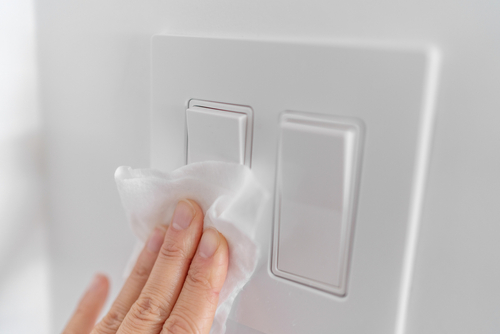As we head into 2023, businesses are looking for ways to promote cleanliness and health in the workplace. However, some of the most at-risk areas of offices, hospitals, schools, and retail establishments are consistently overlooked in regular cleanings. Some of the most touched areas in your space are also the last spots you would think to clean. Here are some tips for keeping high-touch areas clean in your daily cleaning routine.
What are high-touch areas?
A high-touch area is any surface that many different people frequently touch with bare hands. Examples of high-touch areas are: door handles, railings, light switches, kitchen appliance handles, shared office equipment, and more. When someone sneezes, coughs, or touches their face and then touches one of these surfaces, they transfer their germs to that surface. Every person that subsequently touches that surface is also exposed to the germs.
How do high-touch surfaces spread illness?
An object, surface, or material that can transmit illnesses via touch is called a fomite. Depending on the virus or bacteria in question, different textures, shapes, and materials are more likely to become fomites than others. When a person who is sick touches a surface, and it becomes a fomite, they can spread their illness to every person that also touches that surface. High-touch areas have a high transmission factor because so many different people are touching the same surface over and over again.
Where are some frequently forgotten high-touch areas in my workspace?
While your regular cleaning routine is likely to include bathrooms, countertops, and even door handles, here are some commonly missed high-touch areas in your workspace:
- Computer accessories, like your mouse, keyboard, or trackpad
- Chair arms
- Lunchroom appliances (coffee pot, microwave, refrigerator)
- Telephones
- Printer/copier lid and control panel
- File cabinets
- Drinking fountains
- Light switches
- Presentation devices and remotes
If you do not include these objects in your daily cleaning and sanitization schedule, you could unknowingly contribute to the spread of illnesses in your workspace.
What are the CDC guidelines for cleaning high-touch surfaces?
The CDC recommends cleaning high-touch areas every day with soapy water or disinfectant. Microfiber cloths and industry-approved cleaning solutions can ensure a thorough, deep clean every time. It is important to note that while utilizing anti-microbial and antibacterial cleaners can help sanitize your workspace, the CDC recommends moderate usage of these cleaners as frequent or daily use can lead to highly resistant bacteria. Using a variety of standard cleaners with antibacterial cleaners in rotation to clean high-touch areas is one of the best ways to combat illness in your workspace.
Encouraging employees to wash their hands frequently and establishing hand sanitizer stations around your workspace can also help reduce the frequency of transmission in high-touch areas. Stopping germs at the source can reduce the number of fomites in your work environment.
High-touch surfaces can be challenging to clean and are easy to overlook. But including high-touch surfacing in your cleaning routine is a significant part of keeping your workspace clean and germ-free. Cleaning high-touch areas daily can reduce the spread of illnesses and promote a safe, healthy work environment.



